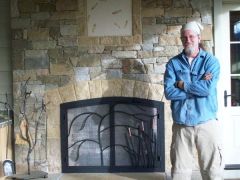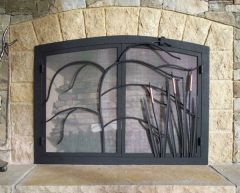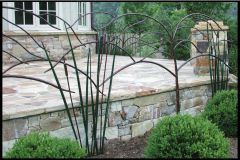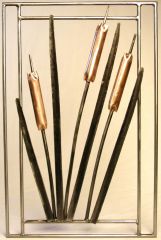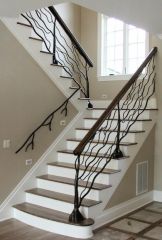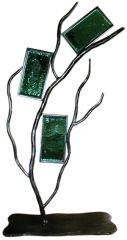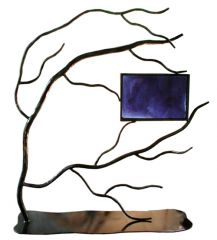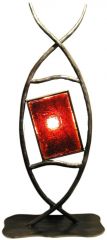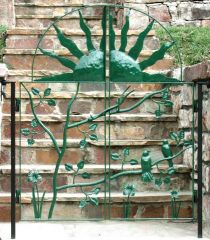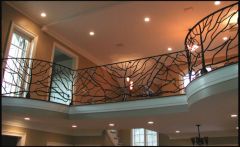
frogvalley
Members-
Posts
201 -
Joined
-
Last visited
Content Type
Profiles
Forums
Articles
Gallery
Downloads
Events
Everything posted by frogvalley
-
I think you all have hit on some of the design elements that I was trying to get across. Thanks for the feedback and compliments. Justin- The blue glass actually does represent the juxtaposition of modern tech, specifically the TV screen, with nature, ie the trees. Original theme/title is Television in the Forest or something similar.
-
home built power hammer
frogvalley replied to devon blacksmith's topic in Power Hammers, Treadle Hammers, Olivers
As long as you don't need an industrial hammer, a home built hammer is going to be just fine. The LG and Tire hammer styles , in my opinion, will not allow a 100-200 lb ram to reliably swing all that weight without a seriously beefy frame. The designs I see around ain't beefy, they are cheap and easy. The forces involved in those hammers can put quite a wobble into a frame. If I were to build another home built I again would chose a spring helve hammer, similar to the Rusty and Appalachian hammers. I built one 6 yrs ago , a 75 lb, and have made over $100,000 with it. Yes, it ain't as accurate or as powerful as a commercially available hammer, but it cost under a $100 to make (less labor costs of course). And it makes a great show piece and story during my big demos and studio tours. I recently purchased a 300 lb Bradley, also a helve hammer. But the home built will never be obsolete. You can see a pic of mine on my website, or here wayback in the archives under power hammers. -
Bradley 300# Hammer
frogvalley replied to frogvalley's topic in Power Hammers, Treadle Hammers, Olivers
There appear to be many different weights to these hammers. Mine weighed in at under 11,000 when trucked in to me. With anvil. I plan to move the anvil around and I'll check to see if its hollow, but I think its solid and the hammer weights including rams varied. I also believe that stated weights include the motor and stand, which were considered as part of the package unless otherwise specified. I have an original motor without stand and I know that thing weighs around 4-500 and the stand was cast iron I think. -
Bradley 300# Hammer
frogvalley replied to frogvalley's topic in Power Hammers, Treadle Hammers, Olivers
Patrick, When I take it off, I'll weigh it. Is it possible that the 500# and the 300# hammer take the same size of ram only in different weights and your hammer has the ram for the 500? I am curious now. What do you suggest for testing the rubber cushions for functionality? I mean how do you know if they have lost too much of their spongyness? Is there a specific durometer or rating for these? Mine don't seem cracked but they do seem rather hard and don't know how soft they should be. Do they "dry rot"? What did you do about the cracks in your ram? -
-
-
-
Bradley 300# Hammer
frogvalley replied to frogvalley's topic in Power Hammers, Treadle Hammers, Olivers
After two years of waiting, the hammer is finally here. Weighed in at 11,000 lbs. without motor. Gonna take her apart and clean her up, but everything looks to be in good shape, no cracks, bushings/bearings good, just need to clean her up, dig a 4x5x8 foot hole and fill it with concrete for a foundation. other than that its a peice of cake.. I'll have her in service by the spring. Here are more pics of the arrival- Mark Schwenk's Photos - The Arrival | Facebook -
Some images of projects completed
frogvalley replied to AdrianWood's topic in Metal Sculpture & Carvings
Inspiring work. At the risk of sounding a bit snotty, I am not impressed by very many things. The natural grace and flow truly shine through in your art. I finished this terrace railing this spring, doing a fireplace screen in this same theme for the same client. Look in frogvalley gallery for other pics of new stuff. -
1/2 inch copper pipe (Ideas Needed)
frogvalley replied to sdalcher's topic in Metal Sculpture & Carvings
these are two of the current production items that I make for my galleries and shops. each one different and I forge them in batches of about 2-6 at a time. Each cob is 3/4 inch copper, cut random lengths about 4-6 long. I then heat them really low, just past a red. I pull them from the forge with a stainless 3/8 rod(mandrel) and crimp/hammer them onto/around the bar. As it cools it shrinks and simply slips off. Besure to support the backside and roundness as you crimp or you will irreparably distort the shape. For 1/2 inch copper I'd use 1/4 or 5/16 rod for stems, drawn down slightly. I use low fuming bronze rod with a gas torch to attach. for leaves/reeds i use 3/4 x 1/8 drawn to a point and cupped with either a spring die on one of my hammers, or with my swage block. -
-
Each of these pieces is about 4 foot high and has slabs of West Virginia glass from Blenko.
-
#200 Bradley Helve Hammer
frogvalley replied to Falconer's topic in Power Hammers, Treadle Hammers, Olivers
Pad is a little of an understatement for what you need under your hammer. I have a 300# like Patrick does. He is the man, btw. Foundation depth, direct from the foundation plans in the manual. Yes, I too have copies of an owners manual for all the Bradley Hammers. At least parts , all for some , most for others. It's a bunch of paper, Patrick may have it electronically. Any way, from the book- Length at top 7'7" Width at top 3'7" length at bottom 8'7" width at bottom 4'7" depth minimum 5', yep five feet Foundation sizes are dependent upon hammer size, and are supposed to be for virgin soil. You might be able to get away with less, but do so at your own risk. These machines are heavy and they pack a punch that will totaly f$%cking destroy something like a standard garage floor. -
I recommend 1/4 or 3/8 minimum thickness, 1/2 is better. Heated mild steel will scale with just about every fire and thinner stock won't last long. 1/8 will deform under the heat as well. All of my currently in service forges are homemade. Two propane and one large coal. The coal forge is 3/8 thick, with two inch pipe and a good electric blower and diverter. Been in service for years and years. Another consideration is that coal ashes and water mixed are very corrosive. If your sprinkle and pack your fire as many do, this along with heat, will corrode away any thinner stock.

